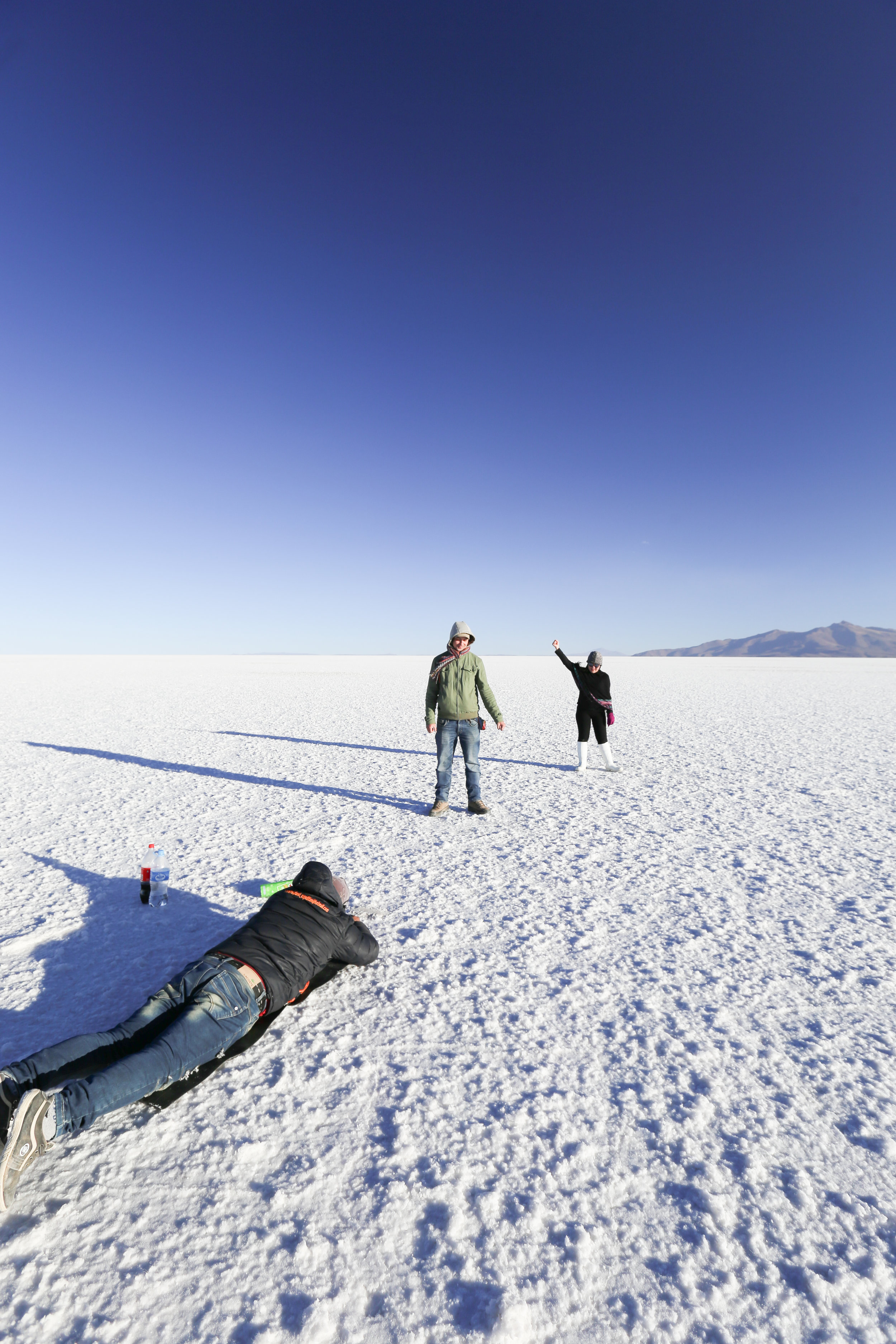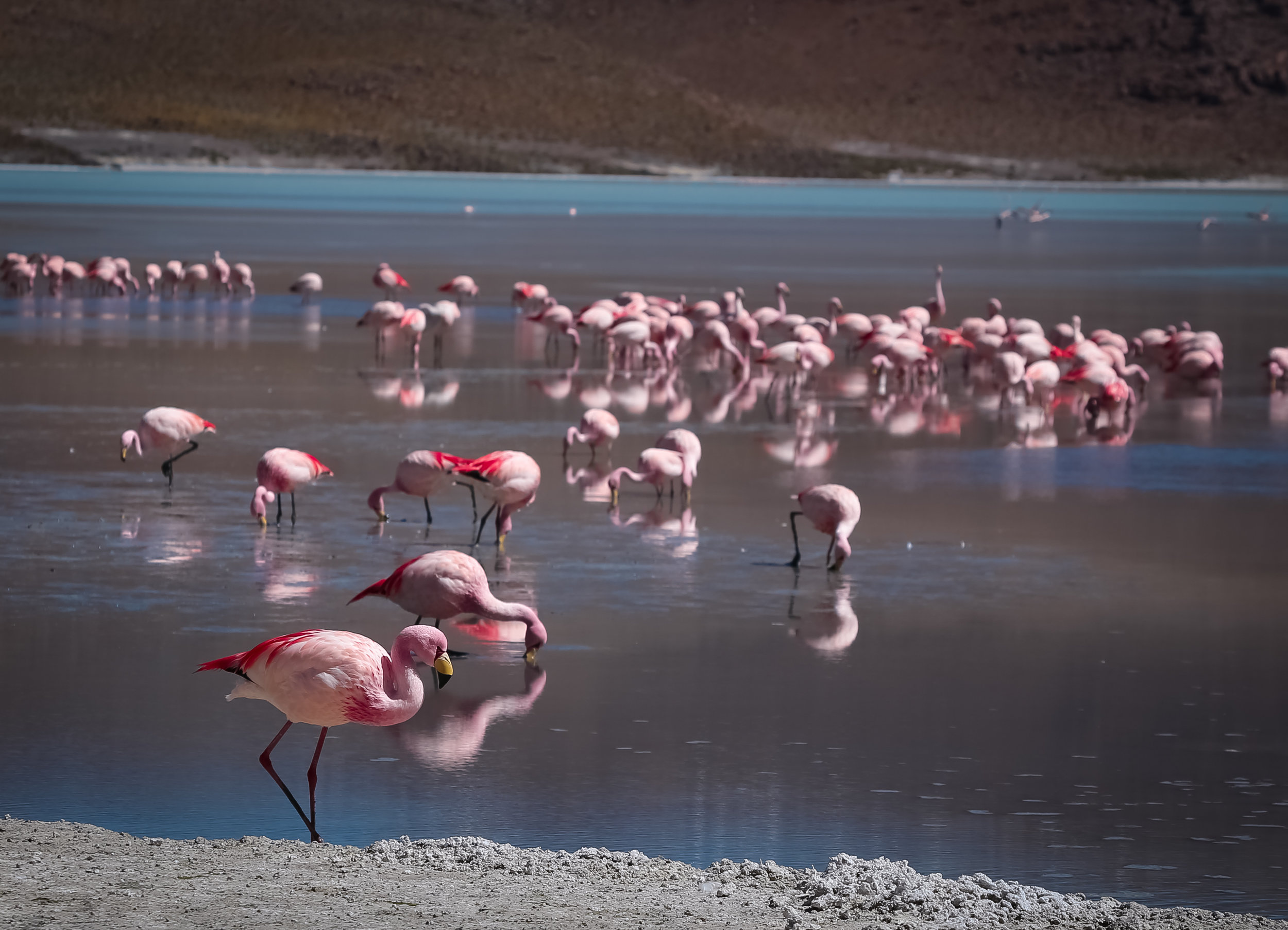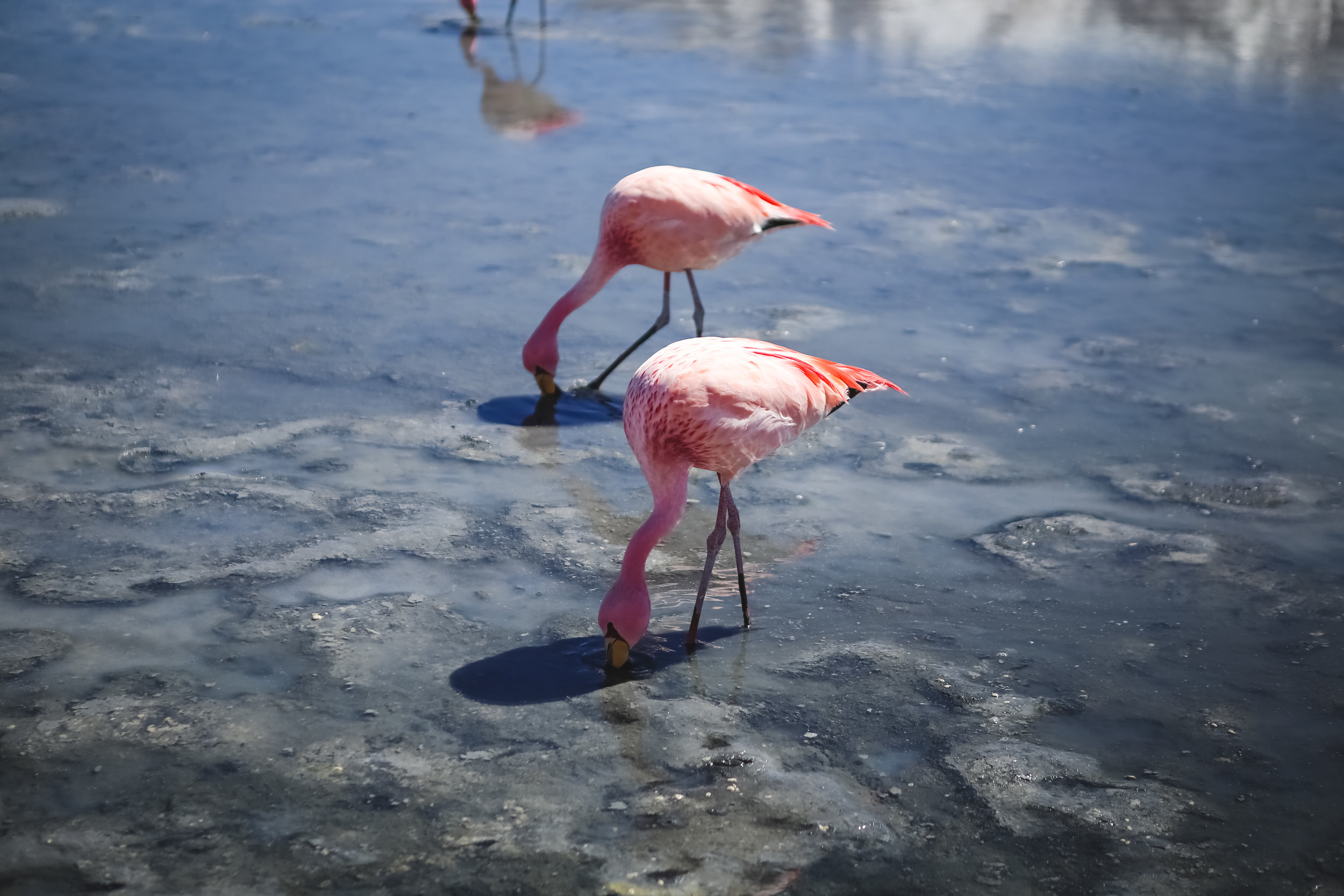4 Days in Salar de Uyuni
Essentials:
Gloves
Beanie/hat/ear warmers
Swimsuit and packable towel
Durable shoe
Passport
Cash
Sleeping bag liner and sleeping bag (bag can be arranged by your tour agency)
Props for Salar pictures
In general: WARM clothing. Think up to -20 Celsius
Cost Summary:
3 day tour: B$700 - 1200
National Park entrance fee: B$150
Isla Incahuasi entrance fee: B$30
Bathroom fees at most stops: B$5 or free if you pay specific entrance fees
Hostel costs per night
Snacks: B$6-10 per day
Hot Springs: B$15? Bring your own towel
Night stargazing tour: B$130+
One of the biggest highlights of my 8 months abroad was the 3 day tour of Bolivia’s Salar of Uyuni - it’s been on my bucket list for years! It should probably be called a 3 day tour of the Salar de Uyuni, Reserva Nacional de Fauna Andina Eduardo Avaroa, and the deserts of Southwest Bolivia seeing as you actually only spend a few hours on the salt flats. The Salar is home to the biggest salt flat in the world at an area of more than 4000 square miles! In comparison, the Bonneville Salt Flats in Utah (which I really want to see) are only 40 square miles.
Our adventure-mobile for the tour. Almost every tour uses these older Toyota Land Cruisers.
Not only were the sites amazing and the nature beautiful, but if you try to match yourself up with a good group, you’ll end up having a blast with new friends.
New amigos!
Tours can begin from the city of Uyuni or Tupiza, and they can end in Uyuni, Tupiza, or on the border with Chile’s Atacama. Given that I was coming from the city of Sucre and didn’t have much time or interest in seeing Tupiza, I went straight to Uyuni and opted to start and end the tour from there. Based on recommendations of other solo travelers, I waited to figure out my group and tour company until I arrived in Uyuni (often if you reserve in advance, the companies can charge a little more because they aren’t desperate to sell seats in the cars - last minute, they’re willing to make deals). I also didn’t book a hostel on time, so the highest rated hostels had no vacancy. I opted for the hostel right next to many of the tour companies and on the main avenue of Uyuni that promised warm showers and heated rooms. Luckily, I made a friend right when I walked in the room (only 2 beds were taken out of the 6 in the room) - a fellow sabbaticaller from New Zealand. We chatted for probably 10 minutes before she told me there was a spot in her tour group for the morning and I should try and snag it. The tour group, Andes Salt Expeditions, was rated OK, and I was excited about traveling with others my age, so I jumped at the opportunity.
Day 1:
We met up outside of the tour agency at about 10:20 AM and met our fellow group members - we had 1 American/Brazilian (me), 1 Kiwi, 1 Brit, 1 Scot, 1 Hong Konger, and 1 German. Funny enough, we all opted for the Spanish speaking tour as it’s a bit cheaper than the English speaking, and 4/6 of us spoke a decent amount of Spanish. We started the tour with ALL the other tour companies at the Train Cemetery a few minutes outside of Uyuni. Basically, it is where the railroad that would take salt from the Salar to the Pacific. Your driver/guide (ours was more of the former) gives you 15 minutes to go take photos before it’s time to move on.
Train Cemetery
After the railroad graveyard, we stopped at a tourist market right outside of town. It was full of the typical sweaters, headbands, toy llamas, etc that you see all over Bolivia. If you don’t have much warm clothing, I would highly recommend picking up gloves, a scarf, and potentially a sweater here as it gets extremely cold at night. Once we started driving on the Salar, it probably took us an hour to get to our lunch spot at the old Salt Hotel and Dakar sign. Here, we parked with about 100 other Land Rovers, took a few pictures with the Dakar (car racing event) sign and salt landscapes while the driver prepared our lunch table, then sat down for lunch. The lunches every day were pretty basic, but very filling. Our food lacked seasoning, but when you’re in the Salar, there is salt everywhere, so scrape a little of the chair and you’re all set!
Next, we drove on towards Cactus Island. It’s literally an island in the middle of the Salar with these giant cacti and coral remains all over it. Its proper name is Isla Incahuasi (house of the Incas in Quechua), and it is what remains of an ancient volcano from when the salt flats were more like an ocean with a few islands. The contrast of the flat, white salt plain against the brown catch filled island is stunning. Here, we received 45 minutes to explore the island… and we took 1 hour and 15 minutes. There is a walking trail on the island, but 45 minutes is only enough if you walk straight through without any stops.
After Cactus Island, we began the LONG journey to the salt hostel where we would spend the night. On the way, we took a 30 minute-ish break to take those salt perspective pictures without 1000 people in the background. We didn’t have many unique ideas, but the driver took control and became a director and had us do a few different silly poses.
On the way to the salt hostel, it feels like you’re going into an area full of bomb shelters as many of the places you pass along the way blend in with the mountain/hills. The place where we stopped had a bunch of rooms with multiple beds and a common eating are in the middle to hangout/eat. While the rooms themselves don’t have heaters, the middle room has a few space heaters, so try to get a table for your group next to the heater! There were also plenty of outlets in the dining area for people to charge electronics. When it comes time to sleep, the rooms actually aren’t too cold..if you have other in the room, if you have a sleeping bag, and if you have a few layers. Tip: if you have the guts, venture outside at night with some friends and check out the stars. I can guarantee they will be some of the brightest of your life. If you can catch a night with no moon or a time before or after the moon has risen, you’ll get a clear view of the Milky Way.
Milky Way outside of Salt Hostel (Night 1)
The morning of day 2, we woke up for a simple breakfast at a reasonable hour and ate in the same dining area that we used for dinner. I would highly recommend drinking some of the coca tea they provide as it’s supposed to help with any symptoms of altitude sickness. Once we set out, our first stop was an area of train tracks that led into Chile. The driver gave us about 15 minutes to play around there, but you probably won’t need more than 5 because there is nothing to explore except one set of tracks with no trains.
The next stop was the first of a few lakes full of flamingos with a beautiful mountain backdrop. We did see a guide yelling at a bunch of tourists for stepping outside the flags - to protect the algae area where the flamingos feed from. Many of the tourists were stepping in that area just to selfie or “do it for the gram.” By doing so, they were destroying the food source of the flamingos (ruining their habitat/endangering them).
We drove a little further to our lunch spot next to a couple more lakes FULL of flamingos. We had lunch with a sweet vista of the flamingos/lakes…Then spent a couple hours in the car on the way to the next stop. FYI if you need to pee, just ask, and the driver will stop in a convenient place for you to do your business. Our next stop was in front of a vista of the Montaña de Siete Colores (Mountain of 7 Colors). Around this area, there are actually a lot of mountains with multiple shades of reds, but this specific mountain has the most visible lines. I’m not sure if all the cars stop here, but even if you don’t, you’ll have to drive through this area and see the mountains from the car. Next we ventured to the Rock Tree or Arbol de Piedra. Although the main thing to see is the Rock tree, there are a bunch of big rocks/boulders surrounding the area that you have more or less 30 minutes to climb around on.
Montaña de Siete Colores
Fox hanging near the cars at the vista for the Montaña de Siete Colores (taken with telephoto at a safe distance)
The last stop of the day was Laguna Colorada - a deep red tinted lake surrounded by contrasting salt, potentially ice, desert rocks, and many flocks of flamingos! Laguna Colorada also sits inside of the national park, Reserva Nacional de Fauna Andina Eduardo Avaroa, where you will spend most of the last day. You will need a passport here to get in and to get a cool stamp, so don’t forget to bring one!
Laguna Colorada
That night we went to a separate bunker type area to sleep within the national park. The main difference was that the shelters were smaller and setup in a sort of town area. We had two groups in our house: Our group fit in one room, and the other group fit in the second room. This night was much much colder as you are sleeping at almost 5000 meters, but they keep a small heater in the common area to help with the inside warmth. We also were lucky enough to see the Milky Way this night, but it was difficult to stay outside - I think we were told it was -20 Celsius outside? If you get to the homes early enough, you can make it to the cute little convenient store where you can buy some wine or liquor to help stay warm.
The last morning, we had to be up around 5 am because not only did we have to make it to the sites and back to Uyuni, but we had to drop off a couple guys in our group at the Chile/Bolivia border. Our first stop was at the geysers Sol de La Mañana. Very cool, but in all honesty, the cold was unbearable, so we were only out of the car for 10 minutes. If I am remembering correctly, the advantage to getting there just after sunrise is that the geysers are more active.
Geysers Sol de la Mañana
After the geysers, we headed over to the Aguas Termales de Polques (hot springs). I didn’t want to get in at first because of the cold, but the springs were actually hot tub warm. We were supposed to be here for half an hour and easily stayed over an hour because they were so enjoyable. There are bathrooms here to change into and out of swimsuits, and you can rent towels if you forgot to pack one.
Hot Springs
Dalí Desert
After the hot springs, we marched on to some of the prettiest colored lakes I’ve ever seen: Laguna Blanca and Laguna Verde (white and green lake). In a huge contrast to Laguna Colorada, these lakes are more of a bright aquamarine. After spending a little bit of time at each lake, we booked it for the border to drop the guys off, then took our time driving for 5 or so hours all the way back to Uyuni.
Vicuñas grazing in front of one of lake
Laguna Blanca
Once we were back in Uyuni, I didn’t have specific next steps, so I decided to stay one more night in Uyuni, and what better way to spend the last night than to do a starlight tour and get some star photos on the reflective part of the flats. I had trouble finding a tour group as the companies will only go out if they have enough people, but eventually I found a company with 1 spot in a group of 7…Not exactly ideal for taking photos where you can’t have light from others. Luckily, I found a guy already paying for a private tour with Brisa Tours, and I offered to pitch in to his private tour and join him so we had less people, and he was more than happy to have someone help him with the cost. FYI, this is called a tour, but the driver just takes you to a spot to take photos and then takes a nap in his car.. I don’t blame him, it was one of the coldest nights of my life.






















